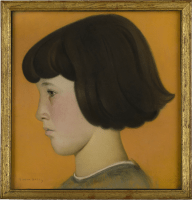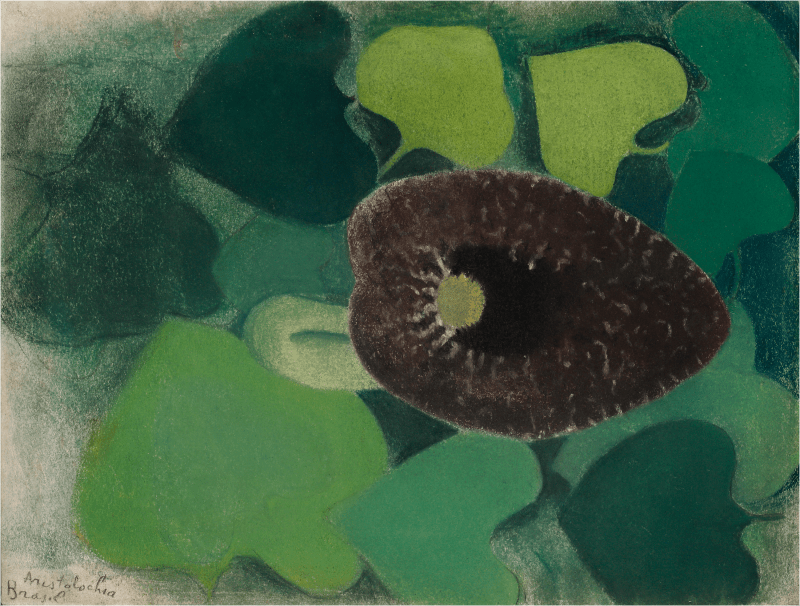To view all current artworks for sale visit philipmould.com
Albert Simon Bussy trained at the École des Beuax-Arts in Paris under the Symbolist painter Gustave Moreau (1826-1898). It was at the pioneering Galerie Durand-Ruel that Bussy had his first exhibition of works in pastel between 1897 and 1899. However, it was his association with the Bloomsbury Group of artists and writers that was to become an enduring influence upon his oeuvre.
On his arrival in London in 1901, Bussy was immediately introduced to the artistic and increasingly Bohemian circles that graced the doors of the London Art Club in Mayfair. Here he met the great English painter William Rothenstein (1872-1945) who greatly admired Bussy’s exhibition then on display at Leighton House.
In particular, it was Dorothy Strachey (1865-1960), novelist and translator, who made the biggest impression on Bussy. Dorothy, through her brother Lytton Strachey, was a closely connected to the Bloomsbury group and published her novel...
To view all current artworks for sale visit philipmould.com
Albert Simon Bussy trained at the École des Beuax-Arts in Paris under the Symbolist painter Gustave Moreau (1826-1898). It was at the pioneering Galerie Durand-Ruel that Bussy had his first exhibition of works in pastel between 1897 and 1899. However, it was his association with the Bloomsbury Group of artists and writers that was to become an enduring influence upon his oeuvre.
On his arrival in London in 1901, Bussy was immediately introduced to the artistic and increasingly Bohemian circles that graced the doors of the London Art Club in Mayfair. Here he met the great English painter William Rothenstein (1872-1945) who greatly admired Bussy’s exhibition then on display at Leighton House.
In particular, it was Dorothy Strachey (1865-1960), novelist and translator, who made the biggest impression on Bussy. Dorothy, through her brother Lytton Strachey, was a closely connected to the Bloomsbury group and published her novel Olivia through the Hogarth Press with the help of Virginia Woolf, who founded the publishing house with her husband Leonard. Simon and Dorothy married two years after first meeting, in 1903. This connection firmly places Bussy and Strachey at the forefront of one of the most enriching and enduring cultural circles of the twentieth century.
Bussy and Strachey later set up a home at Le Souco, the house in Roquebrune near Monaco. Le Souco would soon become famous as an intellectual hub where the artistic and literary elite from both sides of the channel were to convene and exchange their ideas. Lytton Strachey, Duncan Grant, Roger Fry, Vanessa Bell and Virgina Woolf all came to stay at Le Souco for long periods of time. Its place within the history of Bloomsbury is as significant, if not as famous, as 46 Gordon Square, London, the home that Vanessa Bell established with her siblings Virgina, Adrian and Thoby in 1904.
The young girl depicted in this painting is Barbara Strachey (1912-1999) daughter of British Civil Servant and cryptographer Oliver Strachey (1874-1960) and his wife Ray (1887-1940), a prominent feminist politician, mathematician, engineer, artist and writer. Barbara was educated in Switzerland, Vienna and Oxford and later studied history at Lady Margaret Hall, Oxford University. After a long and successful career at the BBC developing the World Service channel, Barbara retired and turned her attention to writing. In 1980 she wrote her first book Remarkable Relations, and the following year published Journeys of Frodo, a detailed book comprising 51 coloured maps which trace the journeys made by the fictional characters in J.R.R. Tolkien’s Lord of the Rings.
The present work is thought to have been painted c.1920-22 and is one of a pair of portraits, the other depicting Barbara’s brother Christopher, Oxford’s first professor of computing. The subtle yet sophisticated tonal harmonies, along with the yellow background to the portrait, are characteristic of the aestheticism explored by the Bloomsbury painters.









